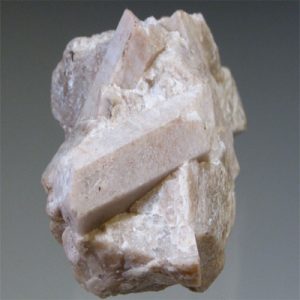Svabite
Svabite is a rare calcium arsenate fluoride mineral that belongs to the Apatite Group of minerals that includesApatite, Mimetite, Pyromorphite, Svabite and Vanadinite. Svabite is at least partially isomorphous with Apatite and Mimetite. Isomorphous means that two (or more) minerals share the same crystal structure but have different chemistries. Svabite is also the arsenate analogue of Fluorapatite. When the mineral Fluorapatite occurs near arsenic-bearing ores, some of the phosphate ions are often replaced by arsenate ions. When the percentage of arsenate ions exceeds that of the phosphate ions the mineral becomes Svabite. Svabite fluoresces reddish orange under LW UV and yellow under SW UV light. If you place your cursor over the picture above you will see the reddish orange fluorescence of Svabite under longwave UV light. Svabite specimens found at Långban, Filipstad, Värmland, Sweden may be associated with another fluorescent arsenate mineral, Tilasite.
Svabite was named in 1891 by Swedish geologist and mineralogist Sten Anders Hjalmar Sjögren (1856-1922) in honor of Anton von Swab (Svab) (1703-1768), Swedish chemist, mineralogist, and mining official at Bergmästaregatan in Skåne and Kronoberg. Swab made important discoveries in the fields fo chemistry and mineralogy. He refined zinc from calamine and later from blende. Together with Axel Cronstedt, Swab developed a commercial process for refining zinc and thus greatly aided the manufacture of brass in Sweden. Swab also discovered the first natural occurrence of native antimony in 1783 from a sample collected from the Sala Silver Mine in the Bergslagen mining district of Sala, Västmanland, Sweden.
Svabite distribution: in Sweden, found in the Harstigen mine, near Persberg, at Jakobsberg, and at Långban, Värmland; from Kesebol, Dalsland; in the Ultevis district, Jokkmokk, Swedish Lappland. In the Clara Mine, near Oberwolfach, Black Forest, Germany.
| Chemical Formula: | Ca5(AsO4)3(F,OH) |
| Calcium Arsenate Fluoride Hydroxide | |
| Molecular Weight: | 636.15 gm |
| Composition: | Calcium | 31.50 % | Ca | 44.08 % | CaO |
| Arsenic | 35.33 % | As | 54.20 % | As2O5 | |
| Oxygen | 30.18 % | O | |||
| Fluorine | 2.99 % | F | 2.99 % | F | |
| — | — % | F | -1.26 % | -O=F2 | |
| 100.00 % | 100.00 % | = TOTAL OXIDE |
| Crystallography: | Hexagonal – Dipyramidal |
| Crystal Habit: | As stout prismatic hexagonal crystals, typically modified by several bipyramids, to 5 mm; also massive. |
| Twinning: | None |
| Cleavage: | Indistinct on {1010} |
| Fracture: | Irregular/uneven |
| Tenacity: | Brittle |
| Moh’s Hardness: | 4.0 – 5.0 |
| Density: | 3.50 – 3.80 (g/cm3) |
| Luminescence: | Fluoresces reddish orange under LW UV and yellow under SW UV. Also cathodoluminescent. |
| Radioactivity: | Not Radioactive |
| Other: | Soluble in dilute acids. |
| Health Warning: | CAUTION: Contains Arsenic, a poisonous element – always wash hands after handling. Avoid inhaling dust when handling or breaking. Never lick or ingest. |
| Color: | Colorless, yellowish white, gray, grayish green; colorless to pale lilac in transmitted light |
| Transparency: | Transparent to translucent |
| Luster: | Vitreous to sub-resinous |
| Refractive Index: | 1.698 – 1.706 Uniaxial ( – ) |
| Birefringence: | 0.008 |
| Dispersion: | n/a |
| Pleochroism: | n/a |


